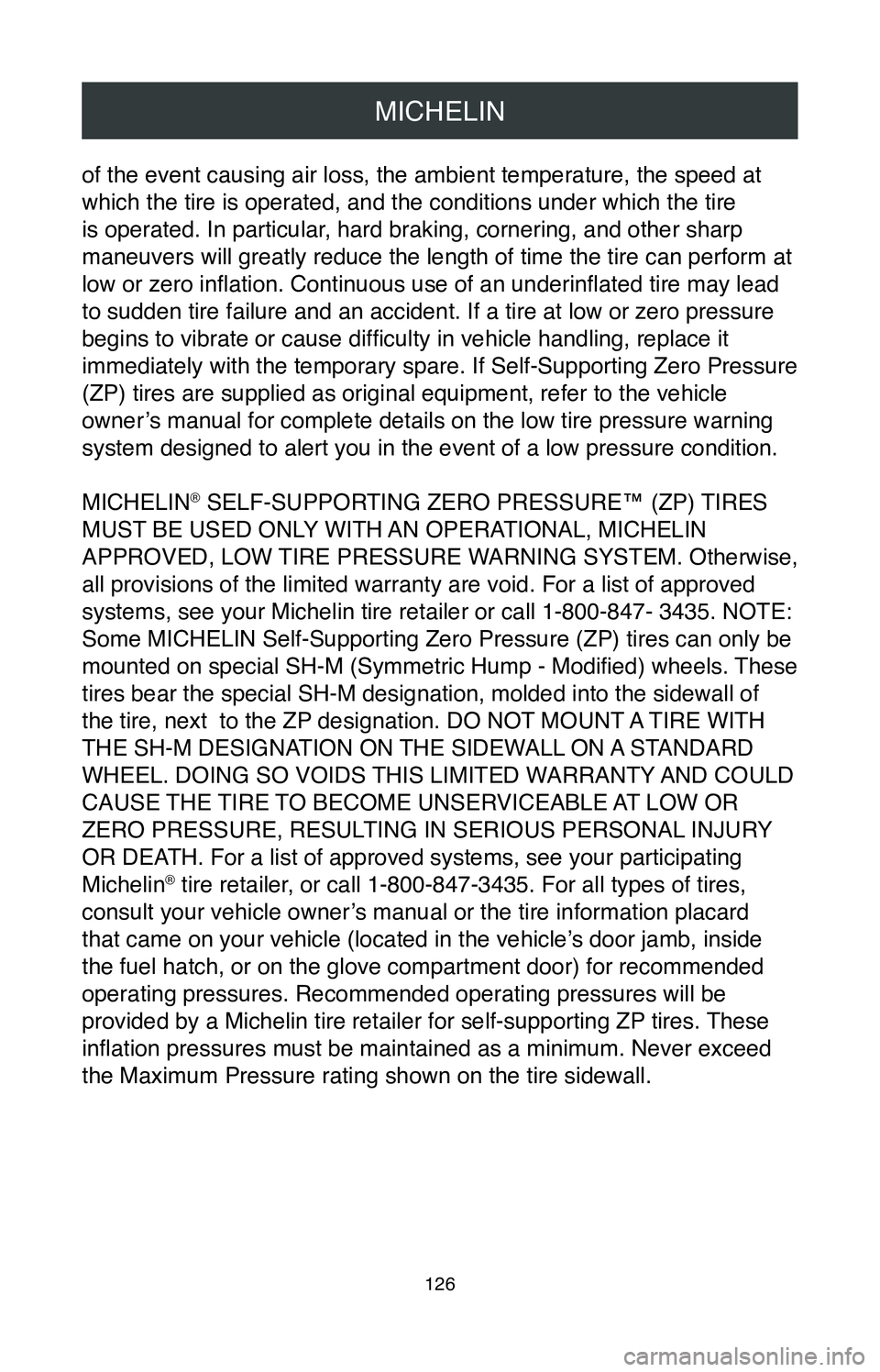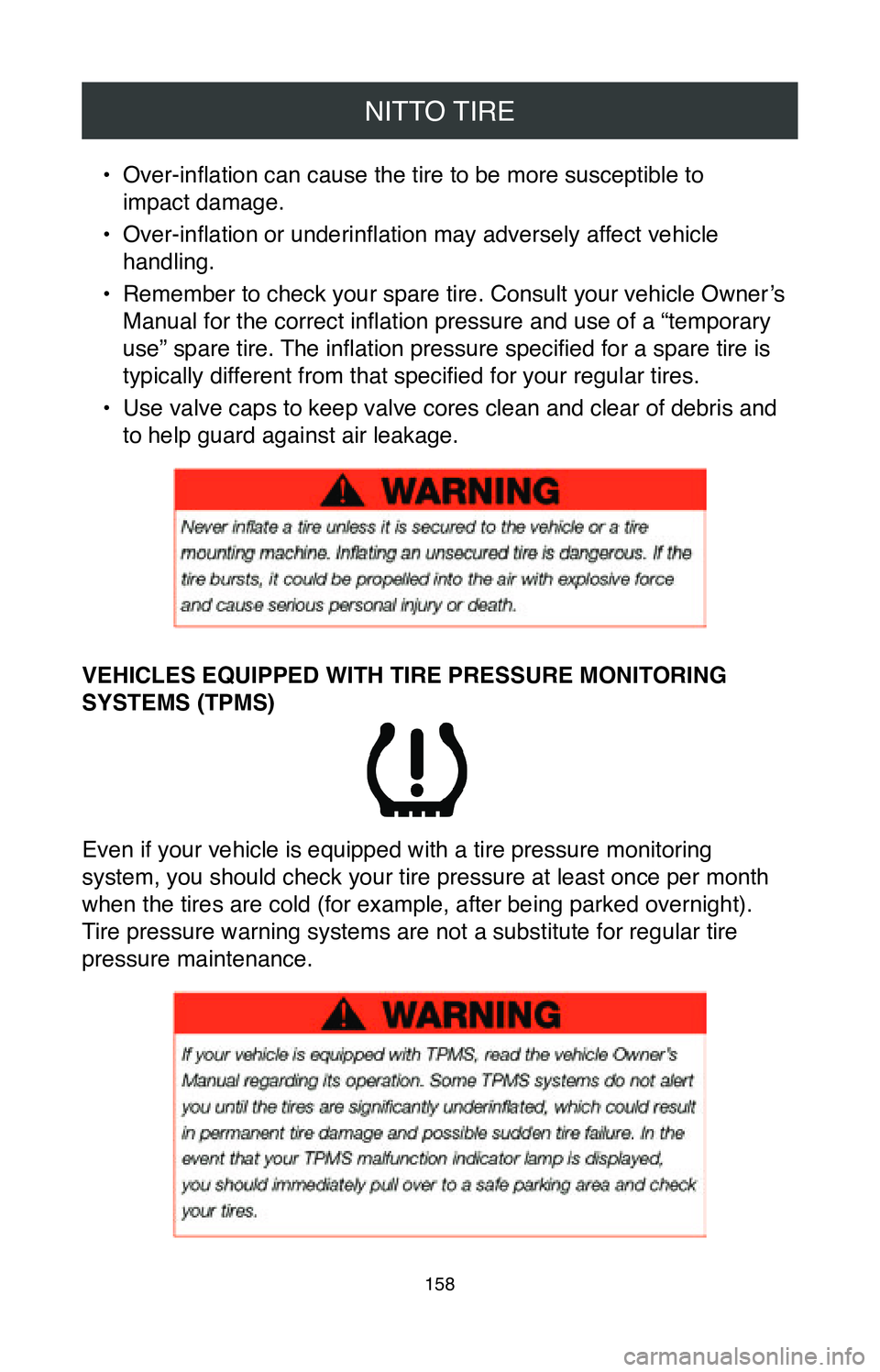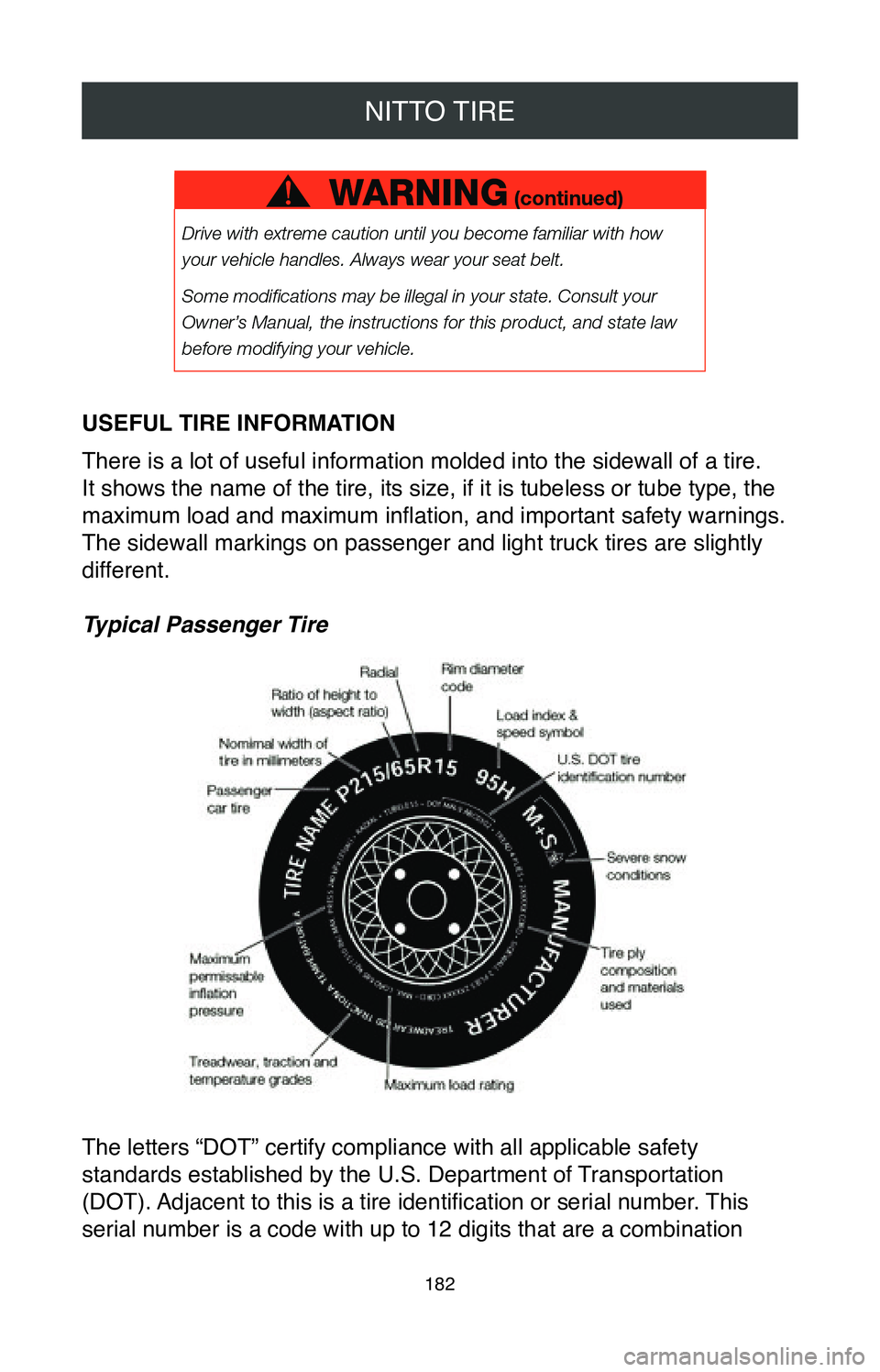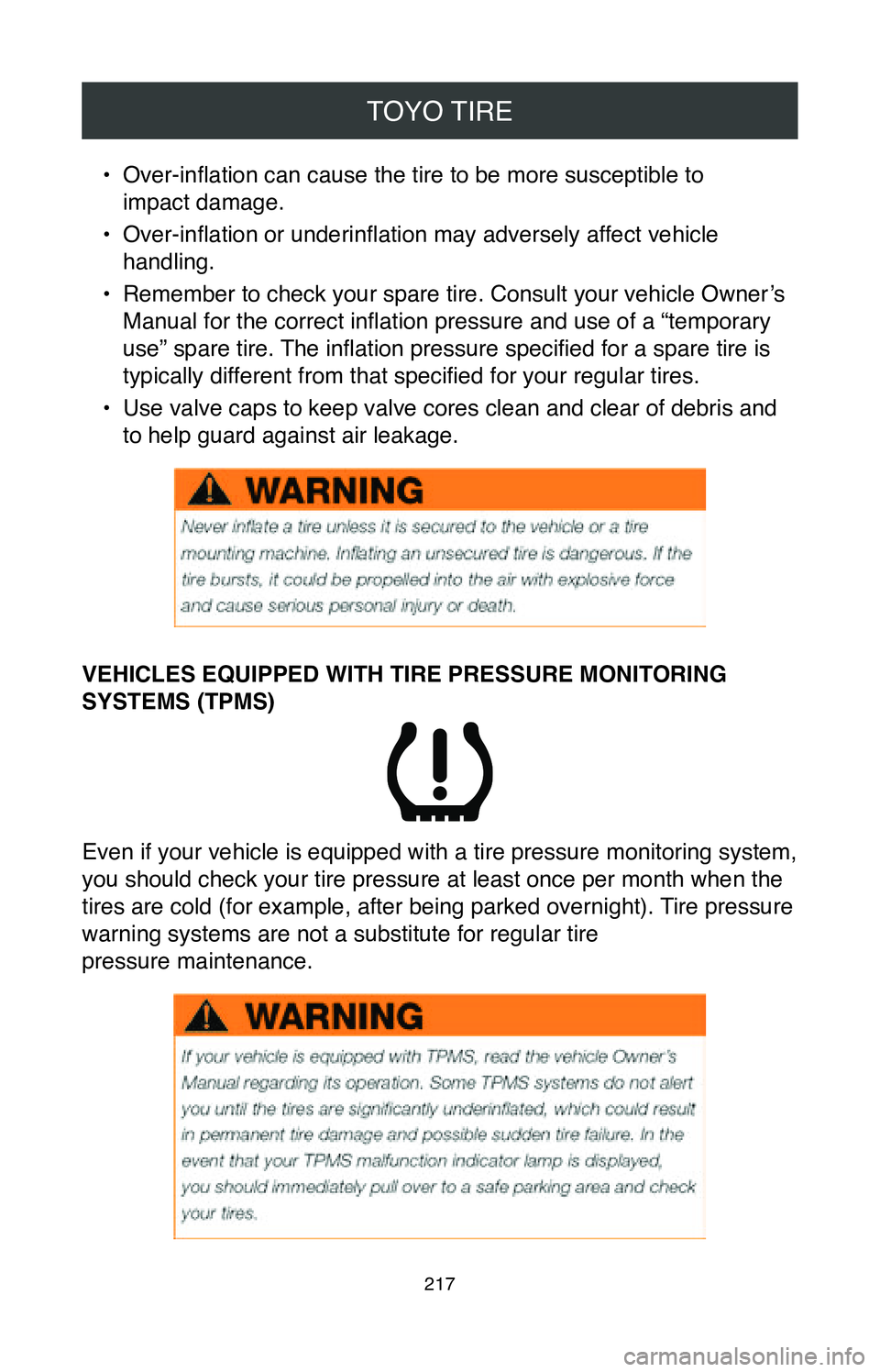warning TOYOTA COROLLA HATCHBACK 2020 Warranties & Maintenance Guides (in English)
[x] Cancel search | Manufacturer: TOYOTA, Model Year: 2020, Model line: COROLLA HATCHBACK, Model: TOYOTA COROLLA HATCHBACK 2020Pages: 260, PDF Size: 8.54 MB
Page 127 of 260

MICHELIN
125
Check the Cold Inflation Pressure in All Your Tires,
Including the Spare, at Least Once Each Month
Failure to maintain correct inflation may result in improper vehicle
handling and may cause rapid and irregular tire wear, sudden tire
failure, loss of vehicle control, and an accident. Therefore, inflation
pressures should be checked at least once each month and before
every long-distance trip. This applies to all tires, including sealant
types and self-supporting tires, which are as susceptible to losing air
pressure as any other type of tire if not properly maintained. Pressures\
should be checked before the tires have been driven on or after they
have been allowed to cool down to the ambient air temperature.
Driving for even a short distance causes tires to heat up and their air \
pressure to increase, and recommended tire pressures are for tires
that have not been heated by recent driving on them.
Underinflation and Overinflation Must Be Checked
with a Tire Pressure Gauge
Tires must be checked monthly with a tire pressure gauge. It is
impossible to determine whether tires are properly inflated by simply
looking at them. It is almost impossible to feel or hear when a tire is \
being run underinflated or overinflated. Use an accurate tire pressure
gauge to check tire pressure each month. Small and inexpensive tire
pressure gauges are available. You should keep one in your vehicle’s
glove box or trunk and use it monthly and as otherwise needed.
Self-Supporting Zero Pressure™ (ZP) Tires at Low
or Zero Air Pressure
The handling characteristics of a vehicle with a deflated Self-
Supporting Zero Pressure (ZP) tire (whether front or rear) are not
the same as those of a vehicle with normally inflated tires. Avoid
high speeds and hard cornering whenever a low-pressure warning is
activated. Even a Self-Supporting Zero Pressure (ZP) tire can build
up excessive heat when run underinflated for an extended period of
time. The length of time and distance a Self-Supporting Zero Pressure
(ZP) tire will perform at low or zero inflation will depend on the severity
Page 128 of 260

MICHELIN
126
of the event causing air loss, the ambient temperature, the speed at
which the tire is operated, and the conditions under which the tire
is operated. In particular, hard braking, cornering, and other sharp
maneuvers will greatly reduce the length of time the tire can perform at\
low or zero inflation. Continuous use of an underinflated tire may lead
to sudden tire failure and an accident. If a tire at low or zero pressur\
e
begins to vibrate or cause difficulty in vehicle handling, replace it
immediately with the temporary spare. If Self-Supporting Zero Pressure
(ZP) tires are supplied as original equipment, refer to the vehicle
owner’s manual for complete details on the low tire pressure warning
system designed to alert you in the event of a low pressure condition.
MICHELIN
® SELF-SUPPORTING ZERO PRESSURE™ (ZP) TIRES
MUST BE USED ONLY WITH AN OPERATIONAL, MICHELIN
APPROVED, LOW TIRE PRESSURE WARNING SYSTEM. Otherwise,
all provisions of the limited warranty are void. For a list of approved \
systems, see your Michelin tire retailer or call 1-800-847- 3435. NOTE:
Some MICHELIN Self-Supporting Zero Pressure (ZP) tires can only be
mounted on special SH-M (Symmetric Hump - Modified) wheels. These
tires bear the special SH-M designation, molded into the sidewall of
the tire, next to the ZP designation. DO NOT MOUNT A TIRE WITH
THE SH-M DESIGNATION ON THE SIDEWALL ON A STANDARD
WHEEL. DOING SO VOIDS THIS LIMITED WARRANTY AND COULD
CAUSE THE TIRE TO BECOME UNSERVICEABLE AT LOW OR
ZERO PRESSURE, RESULTING IN SERIOUS PERSONAL INJURY
OR DEATH. For a list of approved systems, see your participating
Michelin
® tire retailer, or call 1-800-847-3435. For all types of tires,
consult your vehicle owner’s manual or the tire information placard
that came on your vehicle (located in the vehicle’s door jamb, inside
the fuel hatch, or on the glove compartment door) for recommended
operating pressures. Recommended operating pressures will be
provided by a Michelin tire retailer for self-supporting ZP tires. These
inflation pressures must be maintained as a minimum. Never exceed
the Maximum Pressure rating shown on the tire sidewall.
Page 129 of 260

MICHELIN
127
For Self-Supporting Zero Pressure (ZP) Tires, Check
Inflation Pressures as Soon as Possible Following a
Low Pressure Warning
Be certain to ensure that your vehicle’s Tire Pressure Monitoring
System (TPMS) is functioning and is correctly calibrated. Refer to your
vehicle owner’s manual or your vehicle dealer. Low pressure warning
systems are designed to alert the driver to a low inflation situation
in at least one tire on the vehicle. While your ZP tires are designed
to provide continued mobility in the event of an air loss, the sooner
you respond to a warning and take corrective action, the greater the
likelihood that the tire can be returned to service. Always visually
inspect your Self-Supporting tires and use a pressure gauge to check
the inflation in all 4 tires following any low pressure warning (unless
advised to do otherwise by the manufacturer of your low pressure
warning system). If the tire pressure is at or below 18 PSI, proceed to\
the Michelin tire retailer for ZP tires (or a representative of your vehicle
manufacturer if advised to do so in your vehicle owner’s manual) and
have the tire demounted and thoroughly inspected for possible internal
damage. If you are unable to see any damage to the tire, and the tire
pressure is more than 18 PSI, reinflate your tire to the proper inflation.
When tires have cooled, check inflation again. If any tire has lost more
than 5 PSI from the previous pressure check, have the tire inspected
at once by a Michelin tire retailer (or representative of your vehicle
manufacturer if your vehicle owner’s manual so advises.) Failure to do
so may cause irreparable damage to the tire and result in sudden tire
failure and an accident.
Tire Pressure Monitoring Systems (TPMS)
Your vehicle is likely equipped with a Tire Pressure Monitoring System
(TPMS) that is designed to monitor the pressure of tires mounted on
your vehicle and sends a signal to the driver if a tire pressure falls
below a predetermined level. A TPMS should not replace monthly
manual pressure checks for all four tires and the spare. You should
manually monitor and check tire pressure inflation with a pressure
gauge. Your tires should have the recommended pressure listed by
your vehicle’s manufacturer. This information can be found in the
Page 136 of 260

MICHELIN
134
Tires loaded beyond their maximum allowable loads for the particular
application will build up excessive heat that may result in sudden tire \
failure and an accident. Do not exceed the gross axle weight rating for \
any axle on your vehicle.
Trailer Towing
If you anticipate towing a trailer, you should visit your Michelin tire
retailer for advice about the correct tire size and pressures. Tire size
and pressures will depend on the type and size of trailer and hitch
utilized, but in no case must the maximum cold inflation pressure
or tire load rating be exceeded. Check the tire information placard
that came on your vehicle, (located in the vehicle’s door jamb, inside
the fuel hatch, or on the glove compartment door) and the owner’s
manual supplied by the manufacturer of your vehicle for further
recommendations on trailer towing.
Self-Supporting Zero Pressure (ZP) Tires and Trailer Towing
Operation of ZP tires at low or zero air pressure with a trailer in tow
is dangerous and should be avoided. If the low pressure warning
indicator is activated when a trailer is in tow, stop, disconnect the
trailer, and do not continue to tow the trailer until the tire has been
properly repaired and re-inflated to the proper inflation. If the tire
cannot be properly repaired, it must be replaced with a new full-size,
matching ZP tire, and inflated to the proper inflation, before the trailer
can be safely towed again.
Wheel Alignment and Balancing Are Important for
Safety and Maximum Mileage from Your Tires.
Page 160 of 260

NITTO TIRE
158
• Over-inflation can cause the tire to be more susceptible to
impact damage.
•
Over-inflation or underinflation may adversely affect vehicle
handling.
•
Remember to check your spare tire. Consult your vehicle Owner’s
Manual for the correct inflation pressure and use of a “temporary
use” spare tire. The inflation pressure specified for a spare tire is
typically different from that specified for your regular tires.
•
Use valve caps to keep valve cores clean and clear of debris and
to help guard against air leakage.
VEHICLES EQUIPPED WITH TIRE PRESSURE MONITORING
SYSTEMS (TPMS)
Even if your vehicle is equipped with a tire pressure monitoring
system, you should check your tire pressure at least once per month
when the tires are cold (for example, after being parked overnight).
Tire pressure warning systems are not a substitute for regular tire
pressure maintenance.
Page 184 of 260

NITTO TIRE
182
USEFUL TIRE INFORMATION
There is a lot of useful information molded into the sidewall of a tire.\
It shows the name of the tire, its size, if it is tubeless or tube type,\
the
maximum load and maximum inflation, and important safety warnings.
The sidewall markings on passenger and light truck tires are slightly
different.
Typical Passenger Tire
The letters “DOT” certify compliance with all applicable safety
standards established by the U.S. Department of Transportation
(DOT). Adjacent to this is a tire identification or serial number. This
serial number is a code with up to 12 digits that are a combination
Page 201 of 260

PIRELLI
199
that indicated on your vehicle’s tire placard or in your owner’s manual
or higher than the maximum cold inflation pressure molded on to the
tire’s sidewall. Under inflation causes excessive flexing, deterioration of
the tire and rapid wear of the tread edges. Over inflation results in an
uncomfortable ride, a reduced area of tire contact with the road surface\
(i.e., smaller tire footprint), higher susceptibility to impact damage and
rapid wear on the tread center. Whether inflated by air or nitrogen,
regular inflation pressure maintenance remains critical and necessary.
Use of nitrogen alone is not a replacement for regular inflation
pressure maintenance.
WARNING: Driving on tires with improper inflation pressure is
dangerous. These situations can cause a tire failure, including
tread/belt separation, even at a later date, which could lead to an
accident and serious personal injury or death.
Inflation pressure must be checked at least once a month and before
long trips, and should be checked only when the tire is cold or before i\
t
has been driven. Driving even a short distance causes tires to heat up
and the air pressure to increase. Never reduce or “bleed” air from\
hot
tires since your tires will then be underinflated when they cool down.
Always use a reliable pressure gauge.
UHP Summer Tires
The special tread compounds formulated for Ultra High Performance
(UHP) summer tires are optimized for maximum dry and wet
performance in warm temperatures. The compounds in these tires will
have decreased performance, such as lateral and braking traction, at
temperatures below 45° F or when driving on snow or ice. In addition,\
they can lose flexibility and may develop random surface cracks
at very cold temperatures; therefore extra care should be used in
handling tires. All Season or winter tires should be installed for use at
temperatures below 45° F, UHP summer tires are not recommended
for lower temperature conditions.
DOT Street Legal Competition Tires
P Zero Trofeo, P Zero Trofeo R, P Zero Corsa and P Zero Corsa
System tire lines use special tire construction and compounds to
Page 206 of 260

PIRELLI
204
WARNING: Driving on a damaged tire is dangerous, as the tire can
suddenly fail, which can lead to an accident and serious personal
injury or death.
Tire Rotation
Pirelli recommends that you follow the tire rotation procedure as
defined in your vehicle owner’s manual. If there is no procedure
specified, Pirelli recommends tire rotation every 5,000 to 7,000 miles to
optimize your tire wear.
Tire Repair
Punctures, nail holes or cuts located in the tread area of Pirelli
tires may be repaired if the diameter does not exceed 1/4”. The
repair material used must seal the inner liner and fill the injury to be
considered a permanent repair. U.S. Tire Manufacturers Association
and industry approved repair methods include a combination of a
plug and a patch; chemical or hot vulcanizing patches, and head type
plugs; all which are applied from inside the tire. A self-vulcanizing plug
repair may be used only in conjunction with a patch repair, but not
by itself. Plugs may cause further damage to the tire, are not always
airtight and may fail. If a tire puncture exceeds 1/4” or is located \
in the
shoulder or sidewall deflection areas, the tire must be replaced. Never
resort to tubes in tubeless tires or sleeves or large thick patches, whi\
ch
can upset the balance and may result in a sudden failure at highway
speeds and high operating temperatures.
WARNING: Driving on an improperly repaired tire is dangerous,
as the tire can suddenly fail, which can lead to an accident and
serious personal injury or death.
Pirelli Prohibits the Following for Safety Reasons:1.
The use of aftermarket tire sealants in Pirelli tires to repair, even
temporarily, a puncture;
2.
The repairing of V, W, Y or Z Speed Rated tires.
Page 207 of 260

PIRELLI
205
Storage
Should you need to store tires they should be stored indoors in a
cool, dry place. Tire storage areas should be cool (45° F ~ 75° F),
dry, non-dusty, and moderately well ventilated. To protect your tires
from damage related to heat, water, ozone and direct sunlight, it is
suggested you place them in opaque, waterproof containers (e.g.,
plastic trash bags). It is vital that the tires do not come in contact \
with
sources of heat and/or ozone i.e. radiators, electric generators/motors,\
hot pipes, etc., and tires should never be allowed to stand or come into\
contact with water, grease, fuels, brake fluid or any other chemicals.
If you need to transport your tires, please follow the above guidelines.\
WARNING: Driving on an improperly stored tire is dangerous,
as the tire can suddenly fail, which can lead to an accident and
serious personal injury or death.
Tubes in Tubeless Tires
Under no circumstances are tubes to be used in Pirelli tires marked
“Tubeless”. This includes tires that have been repaired. If the tire’s
pressure retention ability has been affected, so as to necessitate a
tube being installed, the tire must be replaced instead.
Tire Valves
Whenever new tires are installed on your wheels, new tire valves of the \
correct type must be installed. During your routine tire inspection, ver\
ify
that all your valves have proper valve caps. Replace as necessary,
since the valve cap is also a seal against pressure loss.
Tire Dismounting and Mounting
Tire fitting should be left to professionals who have the equipment
and training to perform the task properly and safely using U.S. Tire
Manufacturers Association procedures or the vehicle manufacturer’s
recommendations. To maximize the performance of your tires, they
must be installed following the tire sidewall markings with respect to
Page 219 of 260

TOYO TIRE
217
• Over-inflation can cause the tire to be more susceptible to
impact damage.
•
Over-inflation or underinflation may adversely affect vehicle
handling.
•
Remember to check your spare tire. Consult your vehicle Owner’s
Manual for the correct inflation pressure and use of a “temporary
use” spare tire. The inflation pressure specified for a spare tire is
typically different from that specified for your regular tires.
•
Use valve caps to keep valve cores clean and clear of debris and
to help guard against air leakage.
VEHICLES EQUIPPED WITH TIRE PRESSURE MONITORING
SYSTEMS (TPMS)
Even if your vehicle is equipped with a tire pressure monitoring system,\
you should check your tire pressure at least once per month when the
tires are cold (for example, after being parked overnight). Tire pressure
warning systems are not a substitute for regular tire
pressure maintenance.